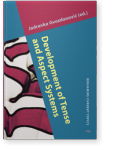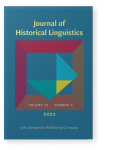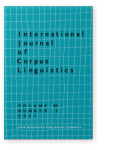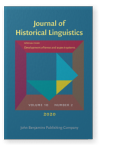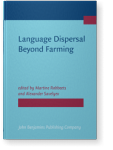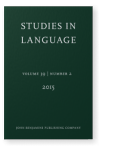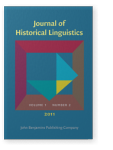Koen Bostoen
List of John Benjamins publications for which Koen Bostoen plays a role.
2022 Kisikongo (Bantu, H16a) present-future isomorphism Development of Tense and Aspect Systems, Gvozdanović, Jadranka (ed.), pp. 105–141 | Chapter
2022 Erratic velars in West-Coastal Bantu: Explaining irregular sound change in Central Africa Journal of Historical Linguistics 12:3, pp. 381–445 | Article
In this article, we present the first quantitative study of what we call multiple unconditioned reflexes (MUR) in Bantu, more specifically of Proto-Bantu velar stops *k and *g in the West-Coastal Bantu (WCB) branch of the Bantu language family. MUR, also known as “doubles reflexes” in Bantu… read more
2021 A diachronic corpus-driven study of the expression of possibility in Luganda (Bantu, JE15) International Journal of Corpus Linguistics 26:3, pp. 336–369 | Article
This article employs a 4-million-word diachronic corpus to examine how the expression of possibility has evolved in Luganda since the 1890s to the present, by focusing on the language’s three main potential markers -yînz-, -sóból- and -andi-, and their historical interaction. It is shown that… read more
2020 Kisikongo (Bantu, H16a) present-future isomorphism: A diachronic conspiracy between semantics and phonology Development of tense and aspect systems, Gvozdanović, Jadranka (ed.), pp. 251–288 | Article
The North-Angolan Bantu language Kisikongo has a present tense (Ø-R-ang-a; R = root) that is morphologically more marked than the future tense (Ø-R-a). We reconstruct how this typologically uncommon tense-marking feature came about by drawing on both historical and comparative evidence. Our… read more
2017 Chapter 10. Were the first Bantu speakers south of the rainforest farmers? A first assessment of the linguistic evidence Language Dispersal Beyond Farming, Robbeets, Martine and Alexander Savelyev (eds.), pp. 235–258 | Chapter
Popular belief has it that the Bantu Expansion was a farming/language dispersal. However, there is neither conclusive archaeological nor linguistic evidence to substantiate this hypothesis, especially not for the initial spread in West-Central Africa. In this chapter we consider lexical… read more
2015 Linguistic innovation, political centralization and economic integration in the Kongo kingdom: Reconstructing the spread of prefix reduction* Diachronica 32:2, pp. 139–185 | Article
In this article we reconstruct the actuation and transmission of a phonological innovation known as prefix reduction within the Kikongo language cluster situated in the wider Lower Congo region of Central Africa. We argue that this change spread from a focal area coinciding with the heartland of… read more
2015 Antipassive/associative polysemy in Cilubà (Bantu, L31a): A plurality of relations analysis Studies in Language 39:2, pp. 354–385 | Article
Antipassive constructions are commonly associated with languages with a predominantly ergative alignment. In this article, we show that antipassive constructions can also occur in predominantly accusative languages such as Cilubà, a Bantu language of the Democratic Republic of the Congo. It is… read more
2013 Bantu-Ubangi language contact and the origin of labial-velar stops in Lingombe (Bantu, C41, DRC) Diachronica 30:4, pp. 435–468 | Article
We examine the origin of labial-velar stops in Lingombe, a language from the northern Bantu borderland. Labial-velar stops are uncommon in Bantu. It is generally believed that they were acquired through contact with neighbouring non-Bantu speakers, in casu Ubangi languages. We show that the… read more
2011 Vowel split in Hungan (Bantu H42, Kwilu, DRC): A contact-induced language-internal change Journal of Historical Linguistics 1:2, pp. 247–268 | Article
This paper examines the diachronic origin of a vowel split in the Bantu language Hungan. It is shown that the inherited Proto-Bantu seven-vowel (7V) system was first reduced to a classical five-vowel (5V) system before the Kipuka variety of Hungan developed a new kind of 7V system. Such a 7V>5V>7V… read more
2011 Passiveness and inversion in Mbuun (Bantu B87, DRC) Studies in Language 35:1, pp. 72–111 | Article
In this article, we examine two word order inversion constructions in Mbuun, a Bantu language which lacks a true morphological or periphrastic passive. Mbuun uses both an ‘OSV construction’ and an ‘impersonal 3PL construction’ as functional passives. We demonstrate that the pre-posed object in both… read more
2008 Bantu Spirantization: Morphologization, lexicalization and historical classification Diachronica 25:3, pp. 299–356 | Article
This paper examines the irregular application of the sound change commonly known as ‘Bantu Spirantization (BS)’ — a particular type of assibilation — in front of certain common Bantu morphemes. This irregularity can to a large extent be explained as the result of the progressive morphologization… read more
